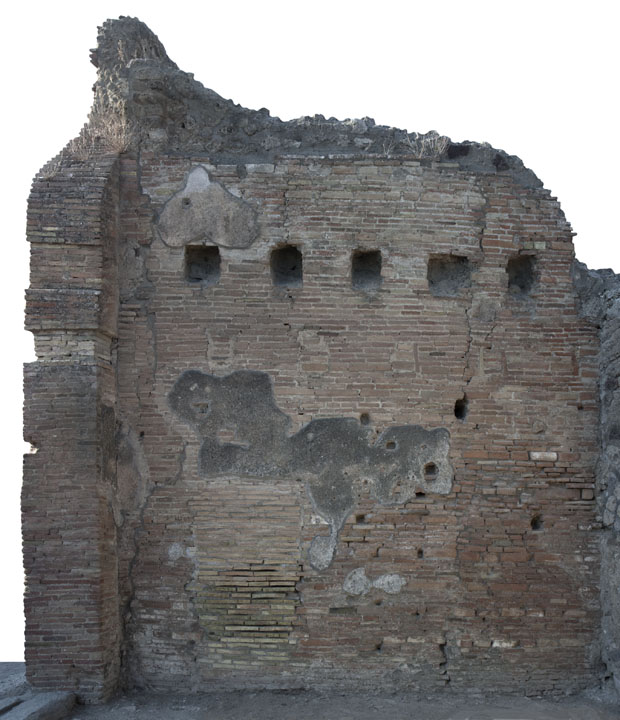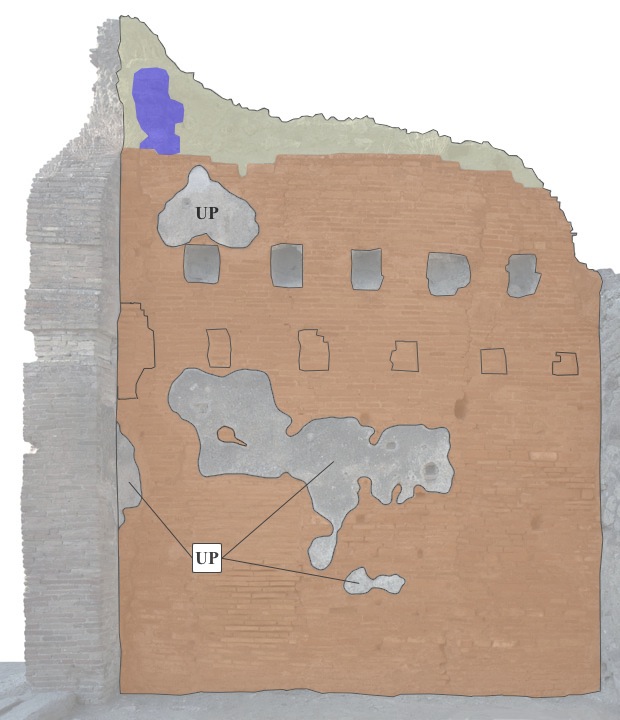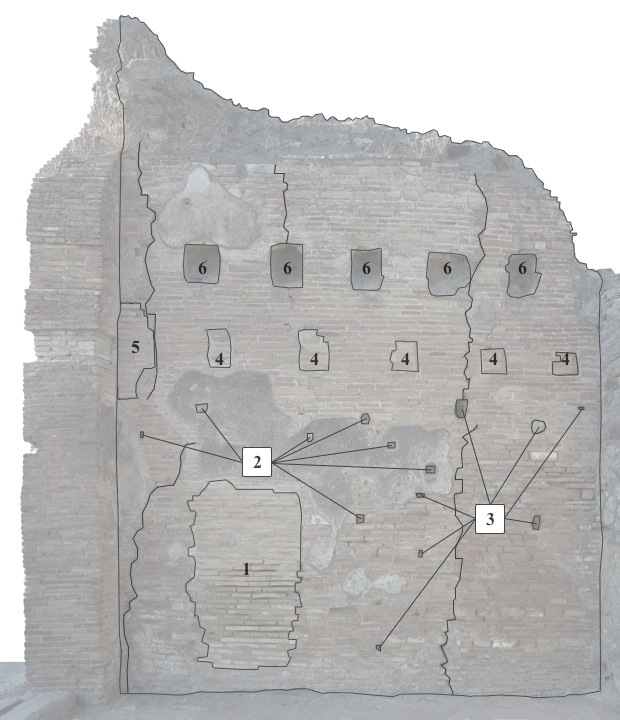North Wall
Description
Mats Holmlund
Ground floor
The wall is circa 3.90 m wide and 3.20 m high in the west corner and 3.05 m in the east. It is built in opus testaceum, but arranged in an opus listatum-like fashion with alternating rows of thinner tiles and rows of thicker roof tiles or bricks. The arrangement varies between three rows of tiles to one row of bricks (3:1), to four to one (4:1) or in some cases to five to one (5:1). The tiles of the wall vary in size between 0.06 and 0.34 m wide and 0.02 to 0.04 m high, while the roof tiles or bricks vary in size between 0.09 and 0.36 m wide and 0.04 and 0.07 m high. The colour of the tiles and roof tiles or bricks varies from beige and yellow to ochre and brown. Some tiles are unevenly burnt and have a dark grey strand in the middle of them.
There are quite a lot features in the wall. First, there is a repaired breach in the wall that is probably a result from a bourbon excavation. The breach is located circa 0.60 m from the west corner and 0.05 m from the floor level. It is approximately 0.90 m wide (at its widest point) and 1.65 m high. The tiles of the repaired area vary in size between 0.03 and 0.27 m wide and 0.03 and 0.04 m high. The colour varies from yellow and pink to greenish yellow.
There are several holes inte the wall that seem to be ancient, partly due to the fact that they sometimes pierce through the extant plaster, and partly because there are remains of ash and lapilli in some of them. The first of these holes is located 0.15 from the west corner and 1.90 m from the ground. It is 0.04 m wide, 0.05 m high, and 0.05 m deep. The second is located 0.60 m from the west corner of the wall and 2.10 m from the floor level. It is 0.10 m wide and 0.08 m high. The third is located 1.50 m from the west corner, 1.90 m from the floor level, is 0.05 m wide and 0.07 m high. The fourth is located 1.90 m from the west corner and 1.30 m from the floor level. It is 0.08 m wide, 0.07 m high, and 0.05 m deep. The fifth is located 1.95 m from the west corner and 2.00 m from the ground. It is circa 0.08 m wide and 0.10 m high. The sixth is located 2.15 m from the west corner and 1.85 m from the floor level. It is 0.08 m wide, 0.07 m high, and 0.05 m deep. The seventh and last is located 2.40 m from the west corner and 1.65 m from the ground. It is 0.08 m wide, 0.09 m high, and 0.09 m deep.
There are a couple of other "manufactured" holes in the wall that may be ancient, but may also be modern. The first of them is located 2.00 m from the west corner and 0.20 m from the ground. It is 0.06 m wide, 0.07 m high, and 0.06 m deep. The second is located 2.35 m from the west corner and 1.00 from the floor level. It is 0.05 m wide, 0.08 m high, and 0.06 m deep. The third is also located 2.35 m from the west corner and 1.45 m from the ground, and it is 0,08 m wide, 0,05 m high, and 0,12 m deep. The fourth and largest is located at a crack in the wall, 2.65 m from the west corner and 2.05 m from the ground. It is 0.10 m wide, 0.17 m high, and 0.26 m deep. The fifth is located 3.30 m from the west corner and 1.20 m from the floor level, is 0.10 m wide, 0.12 m high, and 0.13 m deep. The sixth is located 3.30 m from the west corner and 1.95 m from the ground. It is 0.11 m wide and 0.11 m high, and has a large stone inserted into it. The seventh and final hole is located 2.15 m from the ground and 3.70 m from the west corner of the wall, and it is 0.05 m wide, 0.05 m high and 0.05 m deep.
There are four cracks in the wall. The first starts at the floor level in the west corner and ends 0.50 from the west corner and 1.90 m from the ground. The second begins 0.30 m from the west corner and 2.25 m from the ground, and "ends" at the top of the wall (it continues to the upper floor), 0.20 m from the west corner and 3.25 from the floor level. The third starts 2.25 m from the west corner at the floor level and stops 2.75 m from the west corner and 2.00 m from the ground. The fourth crack begins at the largest hole, 2.75 m from the west corner and 2.25 m from the floor level. It ends 2.80 m from the west corner and at the top of the wall, 3.25 m from the ground (it also continues in the upper floor wall).
There are five "closed" beam holes in the wall (there may have been a sixth, but since the part of the wall where it would have been located is reconstructed, there are only traces of it). All filled beam holes are located between 2.40 to 2.50 m from the floor level and the space between them varies between 0.48 and 0.56 m. The first filled hole is located 0.65 m from the west corner, 2.50 m from the floor level, and is 0.21 m wide and 0.32 m high. The second hole is located 1.40 m from the west corner, 2.40 m from the ground, and is 0.23 m wide and 0.35 m high. The third is located 2.10 m from the west corner, 2.45 m from the floor level, and is 0.23 m wide and 0.30 m high. The fourth is located 2.85 m from the west corner, 2.43 m from the ground, and it is 0.23 m wide and 0.25 m high. The fifth and last is located 3.65 med from the west corner and 2.40 m from the floor level. It is 0.25 m wide and 0.32 m high. The possible sixth would have been located between the west corner and the second crack in the wall.
There is a modern repair in the west corner that probably is related and contemporary to a reconstruction of the upper, northern part of west wall. The repair begins circa 2.15 m from the floor level at the west corner and ends 3.00 m from ground, also at the west corner. It is circa 0.30 m wide at its widest point. The repair consists of yellowish, pink tiles that vary in size between 0.04 and 0.24 m wide and 0.03 and 0.04 m thick/high.
There is a piece of bronze attached to the wall circa 2.50 m from the west corner and 1.35 m from the floor level. The piece is semi circular in shape, circa 0.02 m wide and 0.015 m high, and seems to have fused with the underlying terracotta tile (around the bronze piece some of the original surface of the tile remains and it is seems to have been burnt).
The mortar of the original part of the wall is yellowish grey and contains grains of lava and limestone. In some places, for example 0.30 m from the west corner and 1.70 m from the floor level, where the mortar isn’t that weathered, it is almost pink and quite smooth. The mortar of the repaired parts is grey and contains grains of lava. Modern mortar has been applied to the first, second and third crack (it has also been applied to the fourth one, but only in the upper floor).
There are three areas where plaster remains on the wall. The first is located in the west corner circa 1.20 m from the floor level and is approximately 0.20 m wide (at its widest point) and 0.75 m high. The second and largest area stretches from 0.40 to 2.65 m from the west corner of the wall, and begins 0.90 m from the floor level and ends circa 2.45 m from the ground. The third area almost looks like an "infinity symbol" and is circa 0.50 m wide and 0.20 m high. It is located 1.80 m from the west corner and 0.70 m from the floor level.
The plaster of all these areas is weathered and no decorations, colour pigments or graffiti remains on the surface of them. In area one and two, however, the plaster has a pinkish hue, but this is due to discolourations from the surrounding terracotta tiles. There are several holes in the second area and the underlying wall is visible through the plaster. Some of the holes are from nails (farfalle) that were supposed to keep the plaster on the wall.
Upper floor
The main part of the wall is built in opus testaceum, in a kind of irregular opus listatum-style (the alternating rows of thinner and thicker tiles are four thin, one thick, five thin, one thick, six thin, one thick, three thin, one thick and two thin). Approximately 1.15 m from the bottom part of the upper floor, the method of construction changes to opus incertum and opus saracinescum ("tufelli"-masonry). The incertum-part of the wall is approximately 0.08 to 0.10 m thinner than the testaceum- and saracinescum parts, and consists of limestone and som pieces of cruma. The tiles of the opus testaceum-part varies in size between 0.07 and 0.28 m wide and 0.02 and 0.04 m high, and the roof tiles or bricks varies in size from 0.07 to 0.34 m wide and 0.04 to 0.07 m high. The colour of the tiles and bricks vary from beige and pink to ochre and reddish brown. Some tiles are unevenly burnt and there is a grey strand in the middle of them. The saracinescum or "tufelli"-part of the wall consists of cut pieces of limestone, tufa and cruma. The individual stones vary in size between circa 0.05 to 0.22 m wide and 0.08 to 0.10 m high.
There are five extant (though, originally there was probably seven) beam holes in the wall. The five remaining ones are all located circa 3.05 to 3.20 m from the floor level. The first is located 0.45 from the west corner and 3.18 m from the ground, and is 0.30 m wide, 0.32 m high, and 0.23 m deep. The second is located 1.15 m from the west corner, 3.15 m from the floor level, and 0.25 m wide, 0.32 m high, and 0.30 m deep. The third is located 1.80 m from the west corner and 3.14 m from the ground. It is 0.23 m wide, 0.32 m high, and 0.25 m deep. The fourth is located 2.40 m from the west corner, 3.09 m from the floor level, and is 0.36 m wide (originally it was probably 0.25 m wide), 0.34 m high, and 0.17 m deep. The fifth and final beam hole is located 3.10 m from the west corner and 3.07 m from the ground. It is 0.25 m wide, 0.32 m high, and 0.24 m deep.
The two possible beam holes are located at each side of the extant ones. The first would have been located at the west corner, 3.15 m from the floor level and would have been circa 0.22 m wide and 0.32 m high. The second would have been located in the east corner of the wall and circa 3.10 m from the ground. Both holes are filled with modern mortar and there is no way to determine the original size of them.
There are three cracks in the wall of the second floor. The first is the same as the second crack of the first floor. It starts at the bottom of the second floor and goes through the testaceum-part and stops in the saracinescum-part of the wall. It is located between 0.15 and 0.30 m from the west corner. Modern mortar has been applied to the crack. The second crack is located above the second beam hole, circa 1.30 m from the west corner of the wall. It runs vertically through the entire testaceum-part of the wall. The third crack is connected with the fourth crack of the first floor and begins at the right edge of the fourth beam hole, runs through the testaceum-part of the wall and ends circa 2.85 m from the west corner. Modern mortar has also been applied to this crack.
The mortar of the testaceum-part of the wall is light grey and contains small grains of lava. The mortar in the incertum-part seems to be of the same kind.
There is one area with remaining plaster on the wall. It is located circa 0.30 m from the west corner and 3.45 m from the ground. It is approximately 0.80 m wide and 0.65 m high, and is partly held in place by modern mortar. The plaster is weathered and there are no decorations or traces of graffiti on it. The largest part of the area is yellowish pink, but the top part of it is only pink. There is a hole in the upper left part of the area that may be the result of nail (farfalla) put in the plaster to keep it in place.



